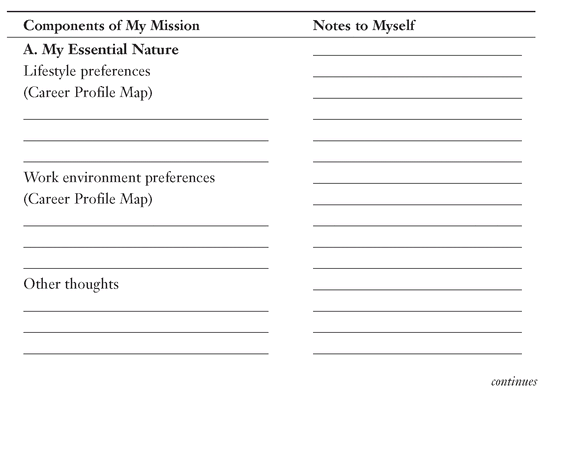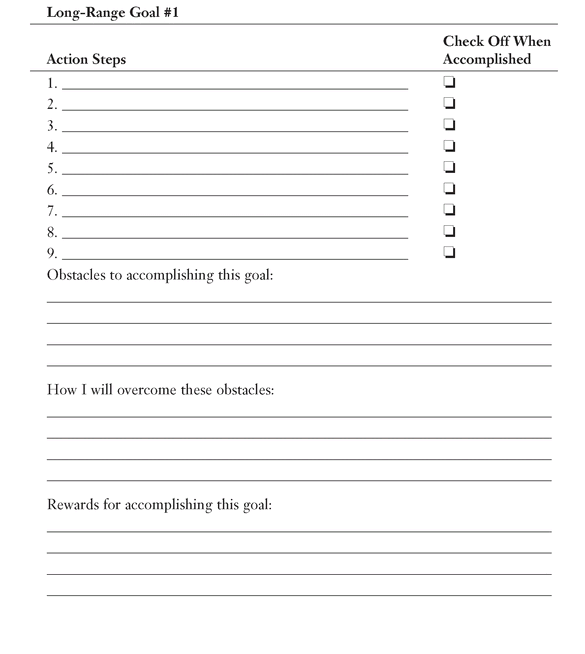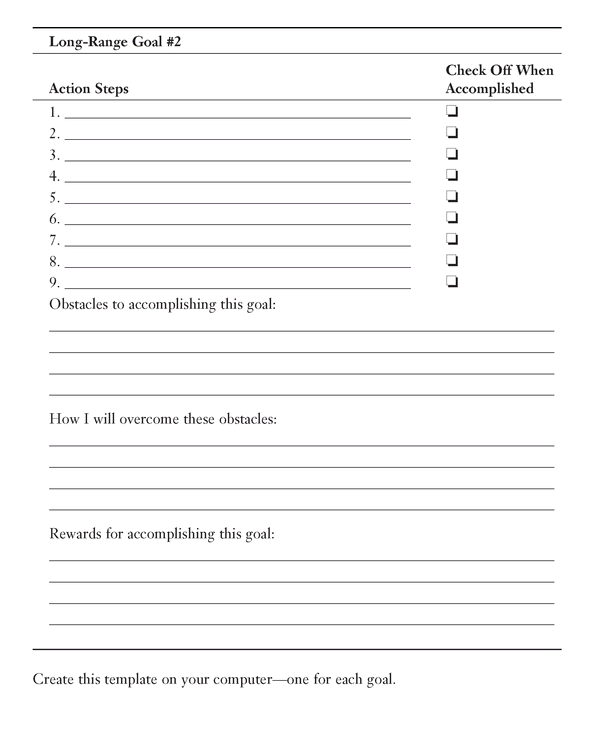Chapter 26
Make a Plan of Action
In This Chapter
• Understand the beauty and productivity of a plan of action
• Create a mission statement to live by
• Set your goals
• Make a plan and stick to it
Well, you have made it all the way to the end of this book on how to find your perfect career. Guess what? This is not the end. In order to make sure that you continue your journey and secure your perfect career, you need to make a plan of action.
So many other things can come into play in our lives to take us off course. We get all excited (and, of course, you are right now) about our own future and goals. Then, the day-to-day happens, and in a month we can be back in our old routines. We don’t forget about our goals, but they sure take much longer to implement without a plan. Don’t worry, in this chapter you will write your plan and learn how to focus your energy on your high-priority goals.
Your Mission Statement
Before we get to the plan, let’s make a mission statement. You already have your vision of what you want your life to be like in five years (your “Vision Summary” from Chapter 5). Your vision represents the inspiration of your long-term goal. It is just out of reach, but always alluring and inviting. Your mission is what is going to drive your behavior everyday. Following are the components of your mission statement. After you read through these, you will have a chance to use a worksheet to write down your components before you actually write your mission statement:
1. My essential nature. This part of your mission statement needs to capture the essence of what is important to you in your life and work. It is the context piece of your mission statement. In other words, you are stating who you are and what you want from your life and your work. Take a look at your Career Profile Map to review your lifestyle preferences and your work environment preferences. You may have other things to add to this, but these two categories can provide a focus for you. You want to create a very concise statement that captures the essence of you.
2. Values. These are the values you want to guide your behavior and decisions everyday in order to be able to live the life and do the work you love. You already have these identified in your Career Profile Map. You are going to want to create a concise statement of the core values (in your own words) that you believe will help you to be true to yourself.
My contribution—this is the work you are doing or want to do. This is the place in your mission statement to identify your perfect career:
• What is the work you are doing or going to do?
• Why is this work important to you?
• How does this work make a difference to others?
Here is an example of a mission statement, using these guidelines:
“My life and work are balanced and intertwined with support and friendships, colleagues, time for family and time for self. I maintain a variety of exciting and interesting projects that I love and are a mix of independent and collaborative work. I work primarily from my home office where I enjoy the beauty of nature all around me.
Guidance in my life comes from my connection to the beauty of spirit in all things around me; my commitment to being trustworthy in the eyes of my family, friends, colleagues, and clients; approaching my work creatively; having fun and being happy; respecting myself; and making a contribution to people’s lives and well being.
I enjoy my perfect career in the field of organization and personal development. The core of my career centers around leadership consulting, career coaching, and curriculum/workshop design. I am open to new ventures where I can build on my core to meet new, creative, and exciting challenges. Everything I do helps others to develop their potential and live an authentic and satisfying life.”
Your mission statement may be shorter or longer. You can mix up the pieces and interchange values, work, and life as you go. This is your mission, so there are no rules! Here is a worksheet to get you started:


After you have filled this out, go ahead and write up your first draft of your mission statement. Sometimes it takes a while to get it just right. Don’t worry about that. Post it where you can see it. Read it everyday. Then make changes as desired! In fact, your mission statement is probably going to change over time as you grow and develop. Remember early on when we mentioned having a “career check-up.” Every once in a while (even yearly), you want to look over your Career Profile Map and see whether there are any changes based on the intervening time that brings new knowledge, experience, and insight.
Identifying Goals
This is the way it works: Vision—Mission—Goals—Plan of Action. You have the big picture and future plan in your vision, you have the day-to-day grounding in your mission, and now you need to identify the goals you want to accomplish moving forward.
First, take a few minutes to think about where you are on your perfect career journey. Some of you will be ready to step into your perfect career. Or you may now want to conduct a job search. Others will need to prepare with more education or experience. And some of you may still need to continue to research your perfect career choices to make sure which one you want to pursue. Wherever you are, you need to take the next step to help you to carry through and do what you need to do to reach your perfect career. Picture yourself in your perfect career right now. Take a minute to close your eyes and see yourself in your career. Now let’s start to form some goals for moving you into that picture for real.
Goals help us to articulate exactly what we want to accomplish. They help us to visualize the outcome or the end state. As stated in Chapter 3, your goals need to be specific, measurable, attainable, realistic, and have time frames.
Long-Range Goals
Let’s start with long-range goals. Look at where you are right now (college, moonlighting, job hunt, researching …), and estimate how long it is going to take you to reach your ultimate goal of being in your perfect career. Some of you may find yourself looking at a very short time to achieve your ultimate goal. Others might find themselves looking at 10 years down the road.
For instance, if you are now in college, studying to be a doctor, you have pretty clear long-range goals like:
1. Graduate college.
2. Apply for medical schools.
3. Graduate medical school.
4. Apply for internships.
If you are conducting a job hunt, your goals are going to look something like this:
1. Write a top-notch resumé.
2. Write an eye catching cover letter.
3. Get references.
4. Use my network to identify job possibilities.
Anything over two months is considered long range. Write down all the long-range goals you can think of right here.

Go back through your long-range goals and rank order these goals in terms of what you need to accomplish first, second, third, and so on. Don’t worry about goals that can be worked on at the same time—this is just a rough estimate of your time line for your goals.
Short-Range Actions
Take the long-range goals from your rank order list that you need to accomplish within the next year and write them down here. Now, think about what you need to accomplish in the next two months. Next to each goal, write all the actions you can think of that you need to take to reach this goal. You can add to these actions every day. As you know, one action leads to another action, so you will be adding to your list as you go along. You should be trying to focus on the present steps you need to take versus confusing yourself with too many long-range actions. Keeping your mind and attention focused on what you have to do right now will get you there much faster.

A wonderful resource to keep you focused on your top priorities on a day-to-day basis is Time Design. Go to www.timedesign.com to look at their products and their workshops. Great stuff!
Action Plan
Here is a simple action plan that you can post on your office wall, your refrigerator, in your day planner, on your ceiling—wherever it will get your attention and keep you focused.

Two-Month Plan of Action

Sticking to Your Plan
How do you stick with a plan and carry it through? Well, you have to develop habits that support you in working on your plan on a day-to-day basis. This is something new that you have to incorporate in your life, and it may require that you change your behavior. Here is something to think about in terms of the type of support you are looking for to change your behavior; this information is based on a study that was done in l993 by Brigham Young University:

So, the next steps to changing your habits to follow through on your plan would be to share your long-range goal and two-month plan with someone in your support network. If you are working with a support group already, this is perfect. If not, write down the names of three people that are in your network whom you think will be helpful in supporting you in your goals. You might consider people who can give you ideas, encouragement, and feedback and challenge you to keep on track. Write down those three names here and when you will contact them to check-in about your goal accomplishments:

Another wonderful way to help you accomplish your goals is to create environments all around you that support your mission. Look around you at where you spend your time. Think about the spaces you spend time in like your office and your home. Consider whom you hang out with on a regular basis. Consider the types of events you attend and the papers and magazines you read—the information and ideas you focus on. Consider how you are treating your body—do you have energy, are you fit, are you healthy? If you think about all aspects of your life the way you did in your Wheel of Life in Chapter 5, you can begin to put your environments in this wheel and rate how well each environment supports your ability to reach your goal. For more information on this, you can take an online workshop at www.Coachville.com.
All the Best
We want to wish the best to all of you who are out there doing the exercises and assessments in this book. Finding your perfect career is hard work, and we know it is well worth your time and effort. You deserve to be happy in work and in life. Although our focus here has been mainly on the work you do, you definitely want to fill out your whole life profile. Go back to your Wheel of Life in Chapter 5 and remember there are a whole bunch of things that make up a perfect life. Although your career is a big piece of your life, there are so many other pieces that yearn for your time and attention, and those pieces are ready to give satisfaction back 10 times over. Life is a journey; you are on it; we support and cheer you. Be happy, be well, do what you love.
The Least You Need to Know
• Making a plan of action will help you to reach your goal of being in your perfect career at a much faster pace than doing without one.
• Your mission statement guides your everyday actions and decisions and is made up of a description of your essential nature—what is really important to you in life and work, the core values that guide your behavior, and the contribution you make through the work you do.
• Action planning begins with setting long-range goals, rank ordering which goals need to be addressed first, and focusing on a two-month plan of action steps to reach your highest ranked goals.
• You have a higher success rate if you make a plan, share your plan with someone in your support network, and check-in on a regular basis for updates with that person on your accomplishments.
• You can do this—you can follow your dreams, do what you love, and work in your perfect career.
..................Content has been hidden....................
You can't read the all page of ebook, please click here login for view all page.
